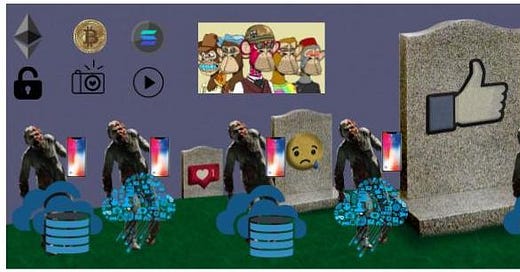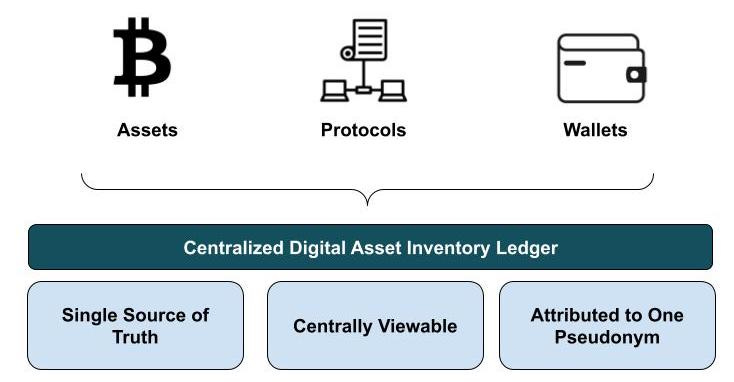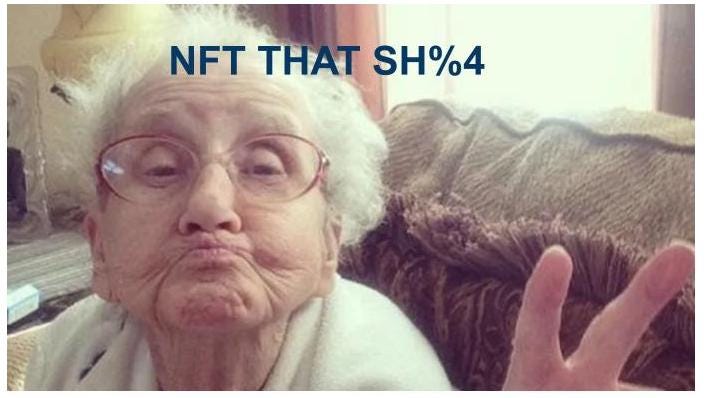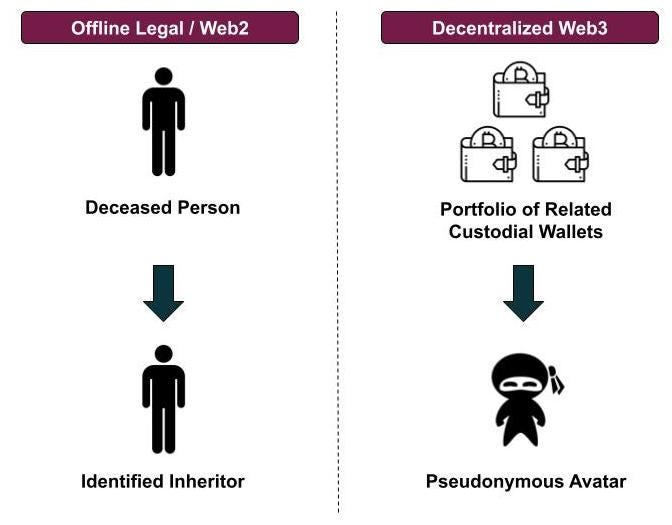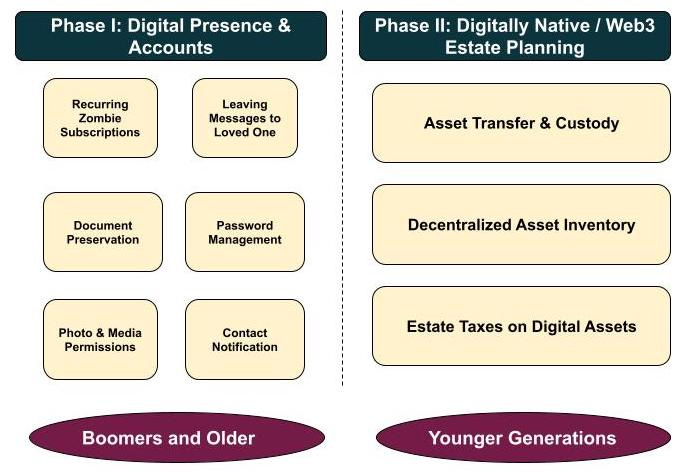The Digital Zombies Invading Your Afterlife
Managing Your Cloud Assets, Data and Identity When Your Body Returns to the Cloud
Welcome back to The Innovation Armory. Today’s piece is a little whackier than other editions and focuses on managing your digital afterlife. And no I don’t mean digital afterlife in the crazy sci-fi sense where your digital spirit lives on forever in a virtual world when you pass. I’m referring to the digital assets, capital, data and identity that the average person who leaves earth also leaves on the web as more of our estates and legacies become entangled with our virtual lives. Read on for more about:
How virtual worlds are eating both our legacies and estates
The mob of digital zombies we leave behind when we pass in this digital day and age
The opportunity to build software to manage web3 estates with a focus on decentralized asset inventories and asset transfer / custody
The uses cases for managing social media, photo permissions, key documents and our recurring subscriptions post-mortem
How to think about web3 estate taxes
How digital afterlife initiatives are equivalent to corporate organizational continuity for the creator economy
Why estates might start minting NFTs from your media to generate estate proceeds through a “digital yard sale”
How the pseudonymity of web3 complicates the will process and why the inheritance question is even more important to answer for crypto than for sovereign, fiat currencies
This is a long post so if your email gets clipped at the bottom, make sure to click unclip / visit The Innovation Armory to check out the full read.
If you’re interested in more thought pieces, you can also subscribe below for future updates from The Innovation Armory:
Also, If you like this piece, feel free to share with the link below:
When you hear the phrase “digital afterlife” you probably think of some of our generation’s classic death tech pop culture references:
Black Mirror’s San Junipero episode where people who die can live on forever in a series of virtual worlds
The Amazon original TV show Upload where people can choose to upload their identities to the cloud before dying to become immortal in virtual space
Don’t worry this is not a piece on metaverse immortality! Don’t let anyone convince you we’ll be able to replicate heaven on earth anytime soon by creating digital afterlives in cloud storage:
For what it’s worth, if you believe AI theoretically can actually reach a point in our lifetime whereby we could create digital representations of humans, then we may live in a computer simulation anyway and these pop culture predictions might be moot. In a universe where this sort of technology is possible, there would likely only be one biologically human reality and many virtual worlds and simulations created by that one human reality to train their AI and study in-depth as a means of advancing the species. It would be most likely that the world you experience is one of the infinite number of possible simulations of the real world rather than the singular actual true biological world. If you’re getting bored of the crypto rabbit hole, try going down the “life is a computer simulation rabbit hole” 🙃, it’s actually really fascinating:
I’m going to avoid both of these rabbit holes and focus on a different type of digital afterlife.
What happens to your digital identity, data and assets after you die?
Virtual Worlds Are Eating Our Legacies and Estates
After death, I’d argue there are two primary activities that most individuals care about that all other activities devolve down to: a) distributing one’s assets fairly and appropriately to family, loved ones or others and b) preserving one’s legacy (e.g. being remembered for what you want to be remembered by). The vast majority of estate planning and death preparedness planning happens through offline activities and legal services, yet the key inputs to each of these two activities are increasingly becoming more digital, especially with each successive generation.
One’s legacy is a function of i) your relationships, ii) memories, iii) work (passion projects, professional) and the cumulative impact all of these factors have on the people who matter most to you and on your community. The share of the interactions that drive these inputs attributable to digital media is increasing meaningfully over time:
How much are our memories shaped by photos, videos, etc. on one’s Instagram account vs. straight brain recall? Definitely meaningfully intertwined.
If you view compute as a bionic means to augment our memory function in our brains, what % of our total memory lies online vs. in our biological brains? Potentially a majority for younger generations
How much of our work reputation will be impacted by digital interactions we have over the next 10, 20 or 30 years? Increasingly more and more as remote becomes more standard especially in knowledge work
These factors are all intertwined with our life experiences and increasingly, the smartphone and internet is our portal for these life experiences as screen time has accelerated across the globe especially since covid-19
One’s net worth includes both traditional and digitally native assets individuals own. On the traditional side, this has historically included one’s home, bank accounts, possessions, traditional business interests, stocks, debt securities. Especially for Gen Z and millennials, over their lifetimes, an even larger portion of their net worth will be held in digital assets like cryptocurrencies, NFTs, DAO tokens and more.
Beyond digital wealth, individuals have monetizable digital property that can be valuable to their family or the market including their social media accounts, owned content and user data
While the bulk of estate planning occurs today for traditional assets, for subsequent generations, more and more of an emphasis will be placed on the digital realm where Gen Z and millennials choose to hold their assets and where they conduct their most valuable activities. Estate lawyers, choose which market pie you’re going to go after carefully here. I’d rather focus on the estate pies so large you’ll need an axe to cut up vs. a butter knife:
Your Mob of Potential Digital Zombies
In our increasingly digital age, as the contributors to your legacy and estate became more digital, there are many potential digital zombies that can continue to haunt your legacy, estate and family after your death:
While I’m sure we will uncover more issues over time as predominantly digital cohorts age, some of the most salient potential issues that are already happening and that I foresee proliferating include:
Decentralized Asset Inventory - There are so many new emerging digital asset categories (crypto, NFTs, tokens) that all exist across different protocols and may be held across different wallet types (both custodial and non-custodial). I think we will run into situations where individuals pass away and because there is no centralized authority of which decentralized digital assets they hold and where they are held, they will be lost or sit forever without being passed on. That might already have happened for some of the top bitcoin wallets where there has been no activity for 5+ years (the top one has a value of over $3 billion!). If no inventory is taken and accounted for in a digital will, there can’t be any actual transfer or re-custodying of assets post-mortem. Individuals intentionally don’t keep their crypto keys in a centralized place to avoid risk of theft or violent seizure, but as younger crypto-native generations age, there will need to be high security asset inventory trackers that are centrally viewable and serve as a single source of truth developed so these individuals can actually pass on their crypto wealth:
Asset Transfer & Custody - Just knowing which digital assets belong to a person, is insufficient to actually enable secure, safe and bespoke transfers of slices of those assets to inheritors. We will need to build out pseudonymous hubs that allow the collection, dissemination and transfer of wallet keys to a series of pre-designated wallets belonging to inheritors. Further, to avoid family disputes over the distribution of one’s assets, I believe there will be a desire to combine and create indices that one can fractionalize out to specific individuals. The demand for this will arise from the fact that certain of these assets have value that is highly subjective and highly volatile (maybe this will change by the time these assets are passed onto the next generation). How will grandpa decide whether to give his grandson the CryptoPunk or Bored Ape NFT? He might rather give a 50% ownership stake in a broader private NFT index he creates to each grandchild:
Photo & Media Permissions - Across their devices, applications and private social media interactions, individuals have a massive amount of media they will have accumulated over the years including photos, videos, memos and more. The individual passing away may want to give permission to certain individuals / family members to access specific media but exclude others from viewing. Moreover, individuals might have sensitive text or media information on their private devices they will want to ensure is locked away with air-tight security to prevent certain information about them from being publicly-leaked as a way of managing their legacies. Some individuals may want to actively leverage photos / videos or written motivational / greeting messages never before shared with family as a way to share affection and care for those left behind post-mortem. All of these use cases will require creating a consolidated, secure repository of post-mortem media with granular abilities to permission viewing, editing and other privileges to specific people.
Social Media Account Security - social media companies currently and generally create commemorative accounts of individuals who pass away. As more of our lives become entangled with social media, individuals will want to take more of an active role in shaping the narrative on their post-mortem social media profiles as these may quite literally become the most public memorial of our legacy. Individuals should be able to choose a) whether they want their account deleted, memorialized or frozen and b) control what is displayed to different types of users when they visit their memorial profiles. Moreover, social media accounts are going to increasingly be thought of more and more as a monetizable post-mortem asset especially for influencers that garnered sizeable audiences and users may want to contribute rights to advertise or monetize those accounts into their wills or even gift their accounts to descendants (especially for those that are pseudonymous where account transfer is unclear).
Composable Asset Usage - As more and more assets and applications in web3 become composable (e.g. stack, layer and build on top of one another), creators (specifically artists) may want more nuanced control over how future builders can leverage their art as an input into another asset or how their app may be called to by other open source applications and may actually seek to build constraints around this usage into post-mortem smart contracts.
Contact Notification - Individuals have ever-expanding social networks enabled by the internet and as the metaverse proliferates further and more contact is made in virtual worlds, users will likely expand their rolodex of contacts to more interoperable platforms and a greater proportion of pseudonymous accounts where the identity of the primary account holder is not even known. As more of our connections are grounded in the virtual, not physical world, from a legacy preservation perspective, individuals will want to have their virtual contacts across platforms be notified of their death who may not know they have died in the physical world given they aren’t in geographic proximity. This also applies to digital services like banks and other fintech products where this notification can catalyze their account to be deleted in order to reduce potential security vulnerabilities of their personally identifiable information across the web post-mortem.
Password Management - How hard and frustrating is it to remember your password for even a couple of websites that you regularly frequent? How difficult do you think it is for inheritors to keep track of all of your passwords for relevant financial, crypto, media and other accounts on top of their own passwords? Pretty wickedly hard 🧙♀️
Document Preservation - this is a simple one, but there are certain documents that will be incredibly important including passports, birth certificate, social security card, the deed to your house and more that people want to make sure are accessible after they pass. Digital afterlife management services can help manage through one centralized repository
Recurring Zombie Subscriptions - As more and more payments go digital and recurring, the average person has zero fu%4ing clue what services they subscribe to. Keeping track of which services you actually use and subscribe to is harder than this incredibly obscure riddle. Please don’t DM me for the answer to this 😡
As of 2019, the average consumer spent an average $273 per month on subscription services (or $3,276 per year). This amount will only increase as more of our lives and assets are housed online. In terms of net $ impact to digital estates, it will become important for families and managers to be able to quickly identify a) which subscriptions are active and b) which can we cut? in order to generate meaningful savings.
Taxes on Digital Assets - There is already tons of complexity, ambiguity and nuance of tax law as applied to crypto assets especially when new digital assets are exchanged for other types of digital assets, how the tax basis of these assets should be calculated and how to track tax liabilities across both custodial and non-custodial wallets and across protocols. Maybe this role will be played by traditional tax advisory firms, but I think there is an interesting opportunity to create software to specifically manage digital asset estate taxes in the most tax efficient manner especially as the regulatory climate evolves more over time.
Digital Afterlife Initiatives Are the Organizational Continuity Systems for the Creator Economy
As we experience a renaissance of distributed creators across education, finance, digital art products, publishing, podcasting, video influencers and more, a greater share of larger enterprises are being decoupled into smaller businesses often managed or run by one sole proprietor, running their business by distributing through social media and leveraging software as best-in-class back end tools. In traditional enterprises, when an executive retires or passes away, there is often another executive waiting to take their place on the bench, but the same is not true of many large creator-driven businesses growing rapidly today.
The fundamental problem here is that unlike an enterprise that built a brand that is independent of any individual within the firm, creator-led businesses have brands that cannot be disentangled or decoupled from the core creator. This implies that creator digital afterlife initiatives are synonymous with organizational continuity in the context of the creator economy.
Because creator-economy businesses engage audiences and distribute via a personal brand, management of that creator’s post-mortem brand (legacy) is critical to enable that business to continue to exist in the future. I think it is foolish to think these creator businesses will cease to exist when these creators die. Creators will put in place organizational transition plans that allow them to gradually turn the keys of their creator business over to new owners (either family or close contacts) or even sell stakes in their creator businesses to new creator owners who will continue to generate profits for their estates. I think these continuity plans will look something like the below:
Solo owners / creators will create a pre-populated content archive (tweets, songs, podcast episodes, greetings, etc.) that they will be able to share with their audience to continue to grow the business post-mortem for the benefit of their estates for a period with minimal involvement from new parties. Sound crazy, what about these post-mortem celebrity appearances and content examples we’ve already seen:
Tupac performing as a holograph at Coachella
The announcement from Amy Winehouse’s estate that she will tour as a holograph
Avicii's posthumous album release
Today’s creators are already seeing unfinished creative work used by the estates of deceased artists and more and more will begin actively planning to hold back content in a posthumous library archived. This content will be gradually released over time as a means of preserving an audience base until introducing a new owner in a content-organic way that has the stamp of approval from the deceased creator. Over time, creators will be able to posthumously grant full access of relevant accounts for new managers / owners to be able to take over and run these businesses.
Digital Data Estate NFT Sales
While some individuals may want to just grant media access to specific people in their network to old pictures / videos, others may want to leverage their digital assets to generate proceeds for their estate. When a family member passes away, estate sales of their items including jewelry, antiques and more are commonplace. As more of our lives go online, individuals increasingly have a trove of potentially monetizable digital assets that could be minted and sold as NFTs including personal writings, pictures, digital art pieces and videos. Especially for influencers that have built a social media following, I think it will become more common to have estate sales of digital assets that estates will mint as NFTs.
I think there is an interesting software play here for an AI that can analyze a trove of media left behind in a digital asset estate and identify which pieces of media have the greatest commercialization potential if sold via an NFT or combined with other media and then minted as a new composable NFT. Even if each NFT doesn’t sell for very much, the aggregate proceeds across thousands if not millions of media / social media posts for even a C list influencer could be fairly meaningful. It doesn’t have to be a luxury estate jewelry sale NFT equivalent, it can be like a basic NFT yard sale, but instead of selling an old table for $5, you sell an old funny video as an NFT for $5.
Remember that picture grandma took of that majestic elephant on your safari trip she thought would never see the world again?
Some creators may even consider issuing tokens for access to these media estates before their death or share value from the minting of these NFTs with their fanbases.
Another area of digital asset property law I find interesting is the issue of tacit consent for data that relates to big tech. Proponents of big tech combat the argument that many of these players “steal user data” with the claim that users are compensated tacitly by their ability to use the product or service at question. What happens when someone dies and their old data continues to be leveraged as an input for big tech algorithms? Should big tech be forced to pay royalties to one’s estate over time once you are deceased and no longer reap the benefit of their services?
Web3 Nuances for the Digital Afterlife
Pseudonymity in a scaled Web3 world complicates the will process meaningfully and requires digital first solutions to bestowing property to inheritors that cannot be solved for by web2 or offline solutions. There are two primary issues that arise:
Individuals with private crypto keys won’t necessarily want to affiliate their real-world offline identity with their digital assets to a centralized system that helps them craft a will for fear that they will be targeted for their keys with violence before they pass
As more meaningful social activity occurs in virtual worlds, more individuals will make friends in a truly digitally-native sense. Most digital social interactions we have today are with offline friends who we keep in touch with via digital technologies. Many individuals in millennial, Gen Z and Gen Alpha may not even know the real world names of some of their best friends rather than a pseudonymous handle or avatar
Web3 changes the nature of the agents / objects involved in the will creation and execution process. Identity can’t be a factor in will construction and is not a requirement of will inheritance either. Instead of Deceased Person bestowing assets to an inheriting person, some wills will need to be structured as a portfolio of non-custodial wallets pooling and then disbursing assets to avatars receiving through their own non-custodial wallets.
Under the current legal paradigm, you need to write and bestow wills for identified people and their inheritors need to be identified so the whole system is unable to operate under a pseudonymous framework.
Additionally, the nature of cryptocurrencies and scarce digital assets makes the effective management of the will writing and execution process that much more important at scale in terms of its potential impact to the currency / decentralized monetary system. In the case of non-crypto assets denominated in sovereign fiat currencies, when someone in the US, for example, dies without a will, their assets are distributed to heirs through the courts through the process of intestate succession. If someone doesn’t have heirs or descendants, because these assets exist either through centralized financial institutions (banks) or on centralized custodial exchanges, they can be seized by the government.
The key point here is that the will system for non-crypto value guarantees the preservation, transfer and redistribution of wealth between generations even in cases where wills are not clearly drawn up whether that be to descendants or to the people through seizure and subsequent government spending.
If you believe in a world where most crypto assets are held in non-custodial wallets, the price to the overall monetary system can be high of a large swath of individuals not writing wills / not transferring ownership of their keys for their wallets. We could end up with a system where there are lots of wallets left frozen / inactive with no descendant or other system stakeholder having the ability to claim it. This represents value lost to the crypto ecosystem that cannot be redistributed. Proper key succession plans or smart contract will-writing will be really important to avoiding this kind of value loss, which the traditional financial system is structurally equipped to already protect against.
As more crypto users age over time, generational value preservation initiatives will play an important role in determining which protocols thrive over the long-term.
Sequencing the Building of a Digital Afterlife Category Killer
It is fairly evident that crypto-native and web3 smart contract based estate management technology will be a critical component of the broader crypto ecosystem. However, when sizing up the market opportunity that exists today in the digital afterlife category, it makes a lot more sense to start on the web2 media, account and legacy side from a sequencing perspective before expanding into web3 financial estate management.
The fact is there is a massive aging baby boomer population and while this population is growing in its appetite for cryptocurrencies, it is both a) much more likely to hold its cryptocurrency on centralized custodial exchanges and b) holds less as a % of generational net worth relative to millennials, Gen Z and future generations will over time. However, many of these boomers and their seniors are highly engaged digitally with social media and other tools that help to alleviate feelings of loneliness.
The larger opportunity that exists for this generation is in non-web3 digital afterlife management instead of trying to outcompete the estate planning industry on a financial assets that the current aging generation is under-penetrated with. These capabilities are a key part of a broader digital afterlife management suite that can be leveraged as a wedge to expand into financial estate planning for web3 assets as those cohorts become more of age / as adoption increases for older generations. Meanwhile, profits from the digital presence and accounts starting point for the business can be used to fund the digitally native / web3 estate planning.
This sequencing strategy will let the eventual winner in this category service the two key stakeholders in this market:
Grandpa Yelling at Bitcoin…
And Grandpa Mining Bitcoin!
All Innovation Armory publications and the views and opinions expressed at, or through, this site belong solely to the blog owner and his guests and do not represent those of people, employers, institutions or organizations that the owner may or may not be associated with in a professional or personal capacity. All liability with respect to the actions taken or not taken based on the contents of this site are hereby expressly disclaimed. These publications are the blog owners’ personal opinions and are not meant to be relied upon as a basis for investment decisions.

